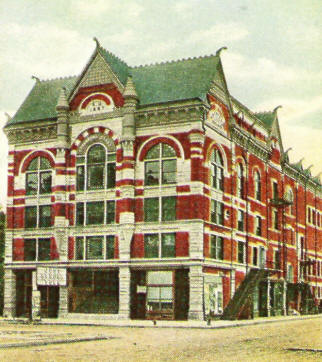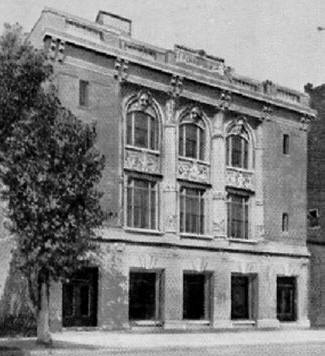|
Two Crawford theaters were once on Topeka
|
THEN: The Crawford Grand Opera House, constructed in 1887, sat on the southwest corner of William and Topeka. The structure was destroyed by fire on April 1, 1913. (Photo credit: Wichita Century, R. M. Long, Wichita Historical Assoc., 1969, p. 80.) |
 |
||
| LATER: The new Crawford Theater was built in 1911 just south of the Crawford Opera House. It was demolished in 1956. (Photo credit: Peerless Princess of the Plains, Two Rivers Publishing Co., Wichita, KS) |
|
||
|
NOW: A large parking lot now occupies the site of both
Crawford Theaters at Topeka and William streets.
|
|
Editor’s note: Information for this article has come from the Tihen Notes accounts of the Wichita Eagle and the Beacon as well as Peerless Princess of the Plains and the online records of WSU and the Wichita Public Library.
In the early days of Wichita, going to the theatre meant enjoying live entertainment in one of the many downtown theatres or "opera houses."
One of the first was the Crawford Opera House, built at the corner of Topeka and William in 1887-8 by L. M. Crawford, of Topeka, and Wichitans O.C. Daisy and P.V. Healy at a cost of $95,000.
George A. Masters was the architect, and St. Louis brick was to cover the east and north fronts with trim of Warrensburg sandstone.
Construction began in the spring of 1887 with plans for completion by Oct. 15. Brick was being laid on the third story by the end of July, however the wall at the west end collapsed in late August.
Nevertheless, work continued, and there was a gala opening of the Crawford Grand Opera House, Feb. 1, 1888. The first performance was the Strauss opera "The Gypsy Baron," presented to an audience which included Dr. and Mrs. Fabrique, Col. and Mrs. Murdock and Mr. M. W. Tanner.
The "parquette floor" seated 542 persons, with tickets for seats in that section generally selling for $2, while the balcony and gallery could accommodate another 1,000 patrons at prices ranging from 50 cents to $1.50.
As with current practices, high school graduation exercises, with a graduating class of eight, including two men and six women, were held in the Crawford in May, and Garfield university commencement exercises were held there in June 1888.
A fire in the Crawford Opera house dressing room section in late October 1907, caused $3000 in damage, foreshadowing its ultimate end.
Sometimes called the Sells-Crawford, other times called the Daisy-Crawford, and later the Crawford Grand Opera House, it was known for live performances. Nevertheless, it did present a demonstration of the Vitascope – an early form of moving picture – in January 1897.
In May 1911 it was the site of what one writer called the "biggest, most enthusiastic suffrage convention ever held in the state." The principal speakers were Miss Jane Addams and the Rev. Olympia Brown Willis of Wisconsin who had campaigned for suffrage in Kansas in 1867. At least 1,400 people attended.
But L.M. Crawford was not content with the success of his opera house. By 1907 he had begun planning to build a new Crawford Theatre, just south of the opera house. That theatre, which ultimately cost $100,000, opened Oct. 2, 1911.
He then closed the old opera house for remodeling, to add another floor, lower the stage to the street level and increase seating capacity from 1,600 to 2,000.
The old theater was to be renamed "The Lyceum Theater" when it opened on Labor Day, 1911. However the old building enjoyed its new life less than two more years, being destroyed by fire April 1, 1913. Its walls were torn down in May 1916.
While the Crawford Grand Opera House lasted only 25 years, the new Crawford Theater, stood 45 years. However its economic course was not smooth. It was sold in 1926, at a sheriff’s sale to the Amusement Syndicate company, of which Mr. Crawford was principal owner, following foreclosure of the mortgage in favor of the State Reserve Bank and L. M. Crawford.
The theatre was closed for remodeling and re-opened Aug. 8, 1931 with "talking pictures."
It had been a "legitimate theater" for 20 years, with such stars as Mary Garden, Otis Skinner, Minnie Maddero Fiske, George Arliss, Maude Adams and Neal O’Brien minstrels making personal appearances on its stage. John Philip Sousa’s band played at the Crawford, and, in 1918, Sir Harry Lauder gave what was billed as his farewell appearance there, but he gave another one somewhere else 12 years later.
The new Crawford theatre had almost double the life-span of the Crawford Grand Opera house, but it was razed in 1956 to make room for a downtown parking lot. So what else is new?
01/08/2009
